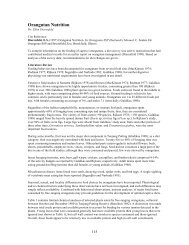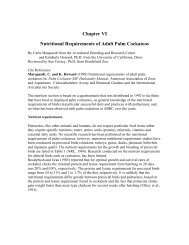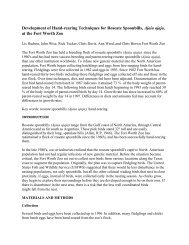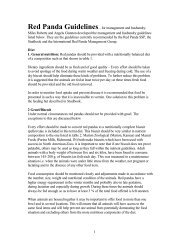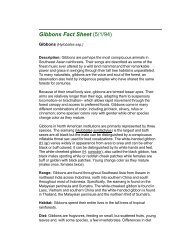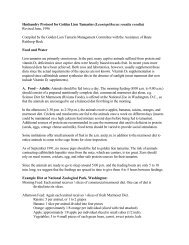Tree Kangaroo Nutrition Chapter - Nutrition Advisory Group
Tree Kangaroo Nutrition Chapter - Nutrition Advisory Group
Tree Kangaroo Nutrition Chapter - Nutrition Advisory Group
Create successful ePaper yourself
Turn your PDF publications into a flip-book with our unique Google optimized e-Paper software.
3.4 <strong>Tree</strong> <strong>Kangaroo</strong> Husbandry Manual<br />
situation in the captive setting may be a<br />
factor of feeding an excessive quantity of<br />
high moisture food items (i.e., commercial<br />
produce, browse). These foods, which are<br />
often preferred over nutritionally complete<br />
foods, provide large quantities of "bulk" in<br />
the gastrointestinal tract. If presented in<br />
quantities which allow the animal to<br />
consume them to satiation, foods which<br />
provide the majority of nutrients and caloric<br />
energy (i.e., nutritionally complete foods)<br />
could be consumed in sub-optimal<br />
quantities.<br />
The energy requirements of tree kangaroos<br />
at stages of the life cycle other than<br />
maintenance (i.e., pregnancy, lactation,<br />
growth) have not been defined. Until these<br />
requirements are determined, many<br />
institutions offer 50% more of the<br />
nutritionally complete feeds in the daily<br />
ration (See below) when the presence of<br />
pouch young is determined. This feeding<br />
strategy is continued until the joey is<br />
weaned. It is important to monitor the dam’s<br />
weight during this lactation to prevent an<br />
inappropriate weight gain or loss.<br />
Carbohydrates<br />
Plant structural polysaccharides, cellulose<br />
and hemicellulose, are the principle sources<br />
of energy for herbivores. The symbiotic<br />
relationship of animals with microorganisms<br />
present in the gastrointestinal tract, which<br />
possess the required enzymatic capabilities,<br />
allows them to utilize these foods. <strong>Tree</strong><br />
kangaroos possess the required enzymatic<br />
capabilities.<br />
Metabolic measurements were taken between 27 o<br />
and 37 o The micro-environment present in the<br />
foregut of these herbivores is a finely<br />
balanced system. The fermentation process<br />
C on animals with a mean mass of 6.96 kg of the microbes produces short-chain<br />
(McNab 1988). The rate of metabolism measure in volatile fatty acids (VFA's), along with<br />
two adult tree kangaroos ( Dendrolagus matschiei) various concentrations of gaseous products,<br />
was 55% of the standard rate expected for a including carbon dioxide, methane, and<br />
eutherian mammal based on Kleiber's (1932) hydrogen. The production of VFA's causes<br />
calculations and 84% of the rate expected for a a reduction in the pH of the contents of the<br />
marsupial based on formulas established by Dawson foregut. Foregut pH is maintained through a<br />
and Hulbert (1970). Based on this work, neither combination of VFA absorption into the<br />
equation appears appropriate for estimating the blood, buffering from saliva, and removal of<br />
energy requirements of tree kangaroos.<br />
contents to more distal portions of the GIT.<br />
C. Protein<br />
Proteins are the principal constituents of the<br />
animal body and are continuously needed<br />
for cell repair and synthetic processes (NRC<br />
1981). There are two primary sources of<br />
protein for species with foregut<br />
fermentation, dietary sources which "bypass"<br />
microbial degradation and the<br />
microbial organisms themselves which pass<br />
through to the gastric portion of the GIT.<br />
The ability of macropods to reabsorb filtered<br />
urea is correlated with the relative medullary



